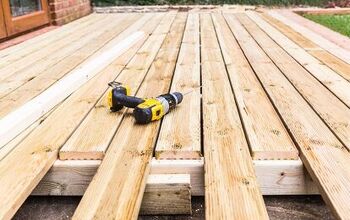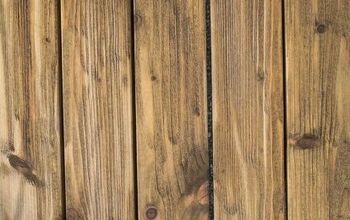Can You Stain A Deck In The Evening? (Find Out Now!)

Staining your deck is a great way to enhance its appearance and protect it from fading and natural wear and tear. The actual staining process is actually pretty straightforward, but it’s important to have the right conditions to do it.
For example, you shouldn’t ever stain your deck in direct sunlight. So, your next question may be: Can I do it at night? The answer:
Yes, you can stain your deck in the evening as long as it is not too cold outside once the sun goes down. Staining your deck in the evening may actually be preferred because it’s important to avoid direct sunlight and the heat. However, it is equally important to avoid cold temperatures and high winds, too.
Here’s everything you need to know about when to stain your deck and how best to do it if you decide to do the project in the evening.
Do You Need Exterior Home Paint or Stain Services?
Get free, zero-commitment quotes from pro contractors near you.

The Best Time to Stain Your Deck at Night
Typically, the best time to stain your deck is in the spring or fall. However, if you are planning to stain your deck at night, you will have to pay close attention to the weather. For best results, you should have dry wood and at least 24 hours of dry weather after the stain job. This is so it can properly cure. Here are the main things that can negatively impact your deck’s stain job:
High Temperatures
The best temperature to stain your deck in ranges from 50 degrees to 90 degrees Fahrenheit. Along with the threat of sunlight and humidity, high temperatures, in general, will cause the stain to dry too quickly. Since it dries so fast, it will not have enough time to permeate the wood properly. And that means your deck won’t be protected or will have uneven penetration and lap marks.
Low Temperatures
As we explained, the ideal temperature for staining your deck should be between 50- and 90-degrees Fahrenheit. When it dips below this, the stain will take much longer to dry. This will affect the curing process, which is basically the time when the stain adheres to the surface of the wood to protect it. The bottom line is staining in cold weather will cause your deck to deteriorate at a quicker rate.
Direct Sunlight
Regardless of the temperature, direct sunlight can have a terrible effect on your drying deck stain. It can cause it to flash dry, which basically means it will dry way too quickly and won’t penetrate the wood properly. This will shorten its longevity and can cause blotches, so you’ll want to redo it anyway.
Moisture
Staining wet wood can cause a bunch of problems. In fact, you shouldn’t use wet wood to build the deck itself. Basically, you should avoid rain at all costs when it comes to any deck construction or staining project. Furthermore, high levels of humidity can cause the stain to dry more slowly, which can lead to more problems with adhesion.
High Winds
Finally, you should avoid very windy days. While wind won’t affect the stain itself, it can blow leaves, twigs, and debris onto your deck before it’s completely dry. This can leave lines and imprints on the stain or just completely stick to the surface.
How to Stain a Deck
You can hire a professional to stain your deck, but it’s not terribly difficult to do on your own either. All you’ll need to know is your deck’s size, the type of stain you need, and the current state of your deck. Here’s what you should do:
- Check the weather. The first thing you should do before staining the deck is to check the weather. This should come to no surprise as it’s basically all we’ve been talking about throughout this entire article.
- Inspect your deck. Before you begin any staining, give your deck a once-over to make sure there’s nothing wrong with the structure itself Look for popping nails, warped boards, rotting wood, or loose areas.
- Get your supplies. Since you’re planning to work in the evening, be sure to have a reliable light source on hand. Other than that, you’ll need however many gallons of stain, painters tape, paint tray, a large paint brush, and a paint pad applicator.
- Test the new stain. There are two main types of deck stains: water-based and oil-based. If you’re not sure which one your deck has on it, run a quick test. Simply apply a little deck stripper to a small area and let it sit for 10-15 minutes. After that, wipe it with a clean rag. It if comes off, it’s a water-based stain. If not, it’s oil based.
- Remove the old stain… Maybe. If your deck already has old stain applied to it, you may need remove it before re-staining. Water-based stains will need to be removed beforehand. Oil-based stains can be recoated after you go over it with a deck cleaner.
- Sweep and clean. After removing all patio furniture, sweep your deck to get rid of any leaves and debris. After that, clean the surface with a wood cleaner and a roller or pump sprayer. Thoroughly clean the surface and keep an eye for any mold or mildew, then rinse everything clean.
- Start to stain. Before you stain the deck itself, start with all the railings and raised features. You can do this with a paint brush. This way, you can walk around your deck freely. After that, you can start on the deck boards itself. This is where the paint pad applicator comes in. Once you’re done, allow the stain to dry for at least a full day.
Related Questions
How often should I stain my deck?
Typically, you should re-stain your deck every two to four years. However, this time will depend on where your deck is located. This will impact how much foot traffic your deck gets, how exposed it is to the elements, and how clean you keep it on a regular basis.
How long does it take to stain a deck?
Staining your deck can take anywhere from two to four hours. This includes sweeping and cleaning the deck, rinsing it off, staining the railings and any raised features, and staining the deck itself.
When can I stain a new deck?
After building a new deck, you should wait between six and 12 months before staining. This is because the wood needs time to dry out and set before you can apply a stain.
Do You Need Exterior Home Paint or Stain Services?
Get free, zero-commitment quotes from pro contractors near you.

Final Thoughts
When it comes to staining your deck, having the right conditions is crucial to the lasting success of the project. Ideally, you should wait for a mild, cloudy day with low humidity, no chance of rain, and low windspeeds. If you’re planning on staining your deck in the evening, keep an eye on all these factors, so you don’t risk botching the entire job.

I am a copywriter and editor based in the Las Vegas area with nearly a decade of experience under my belt writing landing pages, cost guides, blog posts, newsletters, case studies, and social media content. I have a degree in Strategic Communication and experience working in both the account and creative spheres. My goal is to always be discovering new interests and bettering myself as a writer and editor along the way.
More by Kerry Souder



























